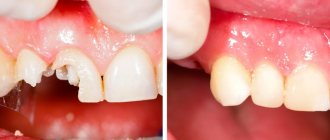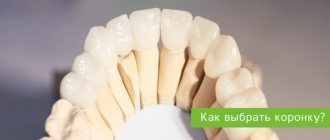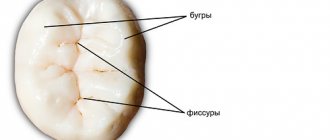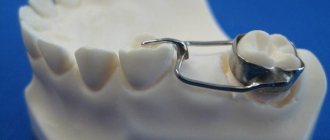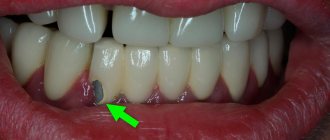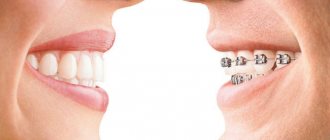- Dental crown - what is it?
- Types, materials, manufacturing methods and photos of dental crowns
- Time and stages of making dental crowns
- Lifespan of dental crowns
- How to best prepare for a visit to a dentist or orthopedist
- Before visiting an orthopedic dentist
- At the dentist's appointment
- After prosthetics
- Which crown is better - metal-ceramic or zirconium?
- Common questions from clients
- About cheap dental crowns, advice
Dental crown - what is it?
A dental crown is a structure that replaces or restores the coronal part of a tooth.
By analogy, the crown can be compared to a soldier’s helmet. A crown on a tooth covers its upper part, like a helmet, on a soldier's head. A dental crown has three main functions:
- Aesthetic (visually retains an appearance indistinguishable from your own teeth)
- Functional (promotes chewing, as it is fully capable of withstanding and distributing the chewing load in full.)
- Protective (preserves the tooth’s own tissues from mechanical and carious damage)
Why do you need to cover (restore) teeth with crowns?
- Tooth decay is the most common reason for crowning. If the coronal part of the tooth is destroyed by more than 50% or the presence of circular caries, restoration of the coronal part of the tooth with an orthopedic crown is indicated. If this rule is not followed, unfortunately, within several years the tooth is destroyed and further restoration is not possible (the tooth will be removed).
- Depulped (nerves have been removed from the teeth) chewing teeth should be covered with orthopedic crowns to avoid chips and fractures of the walls of the crown part of the tooth. The thing is that when depulping (removing the nerve of a tooth), in addition to the nerve, the entire nutrient bundle is removed. In other words, the tooth does not receive nutrition and the materials used to fill the root canal have a strong drying effect on the tooth tissue, that is, they dry out the tooth, and therefore the tooth becomes very fragile.
- Aesthetic defects, such as dental discoloration due to fluorosis, enamel hypoplasia, tetracycline teeth, etc., require restoration through the manufacture of crowns.
- Injuries, in case of traumatic damage to the coronal part of the tooth (fracture, chipped tooth crown), there is often a need for restoration with an orthopedic crown.
- The need for total or partial jaw prosthetics. That is, if it is necessary to replace part of the missing teeth or correct dentofacial deformations, the supporting teeth are covered with crowns, which are part of bridge or splinting prostheses.
- Also, if we are talking about removable dentures, then the supporting teeth are covered with crowns to avoid mechanical damage from excess pressure from the removable denture.
Why depulpate teeth before dentures?
Before prosthetics, the dentist must grind (remove part of the dentin and enamel) the tooth by 1.5 - 2 mm (depending on the material of the future crown) around the circumference. It is impossible to maintain absolute sterility during this process, due to the fact that the oral cavity is not sterile. Therefore, by leaving your teeth “alive” you preserve microbes in your tooth, and over time (from several months to several years) the problem will make itself known and the tooth will have to be removed.
Bonding techniques
As a bonding material between fillings and teeth, composite is effective because new technologies allow the material to be bonded. Two main gluing techniques are used:
- Etching - this method uses phosphoric acid;
- Extrusion - use a binder component that comes with the composite.
When combined with such substances, the composite hardens and is correctly positioned in the tooth cavity.
Clinical use of the composite
Dental restoration with composite material can be used when installing the following types of restoration:
- Tooth filling is the most popular method that includes a substance;
- Adhesive composite bridges are a technique in which a composite tooth is installed in the place of the removed one by gluing it to adjacent teeth;
- Composite inlays are a material that dentists attach to one side of a damaged tooth to strengthen it;
- Veneers – Composite veneers are installed in two ways – directly in the patient’s mouth or in a laboratory setting.
Composite materials provide a great advantage, which allows you to create a good aesthetic effect. This condition is due to the fact that composite materials allow you to choose the optimal shade of the new tooth.
Types, materials, manufacturing methods and photos of dental crowns:
In modern dentistry, metal-ceramic crowns and crowns based on zirconium dioxide are most often used.
Crowns such as solid-cast and stamped are made extremely rarely and mainly in cases where it is impossible or impractical to manufacture metal-ceramic or zirconium crowns.
- Metal-ceramic crowns
They are a combined crown, where the frame (cap) is made of metal, which is later covered with ceramic mass. Aesthetically and functionally, it is practically no different from your own dental tissues. - Crowns based on zirconium dioxide (zirconium)
They are a combined crown, where the frame (cap) is made of zirconium (in other words, a white mineral) which is later covered with ceramic mass. Aesthetically and functionally, it is practically no different from your own dental tissues. Zirconium crowns are more aesthetic due to increased transparency. - Temporary crowns (metal-plastic crowns)
They are made of either composite or plastic. These crowns are slightly inferior in beauty and strength to the above. But they have a huge advantage - they can be made in a matter of minutes right in the dentist’s office. They are used as an intermediate (protective) structure during the production of permanent crowns.
Material
Composite dental restoration and the success of the procedure depend not only on the quality of the substance selected, but also on the correct use of the adhesive material and the light supply system for hardening the filling. Therefore, if the dentist makes a mistake during the procedure or changes the course of action, side effects or the filling may fall out.
The use of composite resins as a filling material has many advantages. Thus, a large number of classifications determines the different composition and types of composites.
The following types of composite are distinguished:
- standard - the disadvantage of this type is a large number of aesthetic defects after tooth restoration, as well as the difficulty in achieving tooth shine after installing the material;
- Fine-grained composite - the disadvantage is the ability to withstand only small loads;
- Hybrid composites have virtually no disadvantages. This is due to the presence of large substances in the chemical composition that ensure strong attachment. Such products have a good aesthetic effect and shine.
Despite the variety, dentistry more often uses traditional material because it is cheap and available.
Time and stages of making dental crowns
To make permanent dental crowns, the dentist will require an average of a week and 2-3 patient visits.
- First visit The doctor conducts a functional analysis. Then the teeth are prepared (depending on the type of dental crown). Takes silicone impressions. Makes and fixes temporary crowns on prepared teeth. Determines the color of future teeth together with the patient. Discusses options for crown shapes.
- Second visit (after 7 days) Trying on the finished structure in the oral cavity. Fixation of the crown with double-hardening cement. If the shape or color needs to be adjusted, another visit to the dentist may be required. Metal-ceramic and zirconium crowns are made in a dental laboratory within 7-12 days (depending on the complexity of the work). More than 5 dental technicians are involved in the process.
We strongly do not recommend using advertising products “dental crowns in an hour”, etc.
Unfortunately, technically, modern CAD CAM systems do not reach the level that a dental technician can make (either aesthetically or functionally) the marginal fit of such crowns, and the aesthetic appearance does not stand up to criticism.
Composite vs ceramic
Composite is most often used in cases of direct restoration of teeth with filling material. With the indirect restoration method, the main material is ceramic, which has great strength and flexibility during installation. In addition, ceramics are resistant to stress and do not wear out for a long time.
The big advantage of the composite is its relatively low price, thanks to which even non-rich people can restore teeth.
Direct and indirect composites
Composite materials used in dentistry can be used in two versions.
Direct composites for teeth - the procedure for their manufacture and installation takes place directly in the patient’s oral cavity. In this way, dental gaps are restored and gaps between teeth are filled.
The indirect method involves the production and hardening of the material outside the oral cavity. Moreover, such materials have greater strength, so they are used in the following situations:
- For the manufacture of composite overlays;
- To restore interdental spaces;
- Restoring the integrity of teeth;
- Making crowns.
Composite crowns
The disadvantages of such products are their fragility, therefore they require regular replacement or correction. Dentists use composite crowns to cover the entire tooth.
Indications for use:
- Impossibility of installing metal-ceramic crowns;
- Temporary crowns.
Metal composite bridges
Composite bridges have a special shell that contains the composite. A type of composite bridge involves installing the product on one or more teeth. Thus, an adhesive bridge is more often used, which involves installation on one tooth. Used when the patient does not have normally developed bone tissue for implantation. The procedure has a lower cost than other restoration methods.
Recovery procedure
The procedure for tooth restoration with a composite includes the following steps:
- Anesthesia;
- Preparation of the oral cavity - includes sanitation of the oral cavity and removal of old fillings, cleaning the site where the composite was introduced, selecting a shade and insulating the tooth;
- Direct restoration using bonding techniques and the use of a binder component.
After complete composite restoration of teeth, final finishing and polishing of the tooth surface, bite testing and additional whitening occur. Restoration of the front teeth with filling material is also used.
Before visiting an orthopedic dentist
- Do not be nervous.
- Before taking (an hour), eat a hearty meal (the process of digesting food reduces strong emotional arousal).
- Try to plan your first visit to an orthopedic dentist for the first half of the day while it is light (only natural light allows you to accurately determine the color of your teeth), before the doctor is tired (we are all human, and in the first half of the day the doctor will pay you more attention and time than in the evening), while you not tired (the patient’s understanding of the process and all stages of treatment is very important).
- Collect all the photographs of your teeth that were taken before (regardless of the statute of limitations), this is often necessary.
- If you have old dental crowns or dentures, you should also take them with you.
At the dentist's appointment
- Try to listen carefully to the dentist about possible prosthetic options. Do not hesitate to ask questions (your understanding of the treatment process is very important).
- Make a decision on one or another prosthetic option. Ask about the timing and total cost of treatment. Ask for a detailed treatment plan indicating the full cost, payment schedules and treatment time frames.
- Check the warranty period. Read the contracts carefully. If something worries you or you have doubts, do not hesitate to take a time out.
Remember! It is better to consult several doctors before starting anything.
Avoid! Promises and bravado, if you have previously consulted with several doctors and only one promised you what others refused, then we advise you to contact those who refused.
Carefully! If the clinic lures you into paying the full amount of treatment immediately REMEMBER that you will not get it back. Try to avoid clinics with this approach to taking money despite the discounts offered.
After prosthetics
- Before prosthetics, finally check the color and shape of the dental crowns in natural light. It’s better to go out into the hall and look in a regular mirror.
- Once fixed, it will be impossible to change the color.
- After fixing the crowns, try to spend some time in the clinic (for example, in the lobby), once again checking the structures in a more relaxed atmosphere.
- Ask your doctor about hygiene and special care practices.
- Ask for the doctor’s contact number (if necessary, ask questions by phone).
- Make an appointment with your doctor in 7 days for a follow-up examination, regardless of the condition of the crowns.
- Professional control is required after 7 days.
- If you experience any problems with your crowns, contact your dentist immediately.
Which crown is better - metal-ceramic or zirconium?
A bit of an incorrect question.
In terms of strength and aesthetic characteristics, these crowns are very close to each other.
On front teeth, zirconium crowns are more preferable due to their increased transparency.
But in the area of chewing teeth, we would not recommend using zirconium crowns due to the lower strength of the frame.
Therefore, the ideal option would be to use metal-ceramics in the area of the chewing teeth, and zirconium crowns in the area of the front teeth.
Fixation methods
- Cement . The implantologist places a special screw into the hole on the abutment. With its help, the abutment is screwed into the implant. The crown is fixed on the protrusion of the abutment. Cement with shock-absorbing properties serves as a fixative. The method is applicable when: the visible area of the abutment is more than 5 mm;
- gums near the implant are higher than 3 mm;
- the bone next to the dental neck is thicker than 2 mm.
- the gum is thinner than two millimeters, and at the implant site its size is less than 4 mm;
- a temporary prosthesis is placed on the implant;
- During the implantation period, the face is operated on - bone grafting is performed;
- the bone next to the dental neck is thinner than 3 mm;
- crowns on an implant of extremely low clinical height.
Common questions from clients
why do the gums darken near the crown??
- Error when preparing a tooth for a crown.
- Error in the manufacture of the crown (non-certified metals or the frame overlaps the ceramics on the outer surface).
- Root caries (a carious process has occurred under the crown), that is, the seal of the crown is broken.
- In all cases, urgent replacement of the structure is required. Failure to follow the recommendation will result in tooth extraction.
why does the tooth under the crown turn black??
the tooth has turned black - this is a symptom of tooth tissue destruction and requires immediate treatment. The dentist will remove the crown and evaluate the condition of the tooth. If a small part of the tooth has darkened, you can fill the tooth and make a new crown.
Is it possible to redo zirconium crowns? ?
Can. For example, if the color of the crowns is radically different from their own. In this case, the crown is sawed and removed without damaging your tooth.
Most often, it is impossible to change the color of the crown without removing it. Unless we are talking about some completely insignificant defect, which can really be eliminated by slightly tinting the porcelain.
If the discrepancy is really serious and very noticeable, the crown will have to be removed and re-fired in a dental laboratory. This is undesirable as it may change the density of the porcelain. In addition, only a crown installed on temporary cement can be removed and put back - when removing a prosthesis installed on a permanent basis, it can become irreversibly deformed.
Is it possible to change the shape of a zirconium crown??
Some changes in shape can be made if the crown is installed with temporary cement.
The ceramic on the crown chipped, why?
- Bruxism (teeth grinding).
- Technical shortcomings in crown manufacturing.
- Incorrect determination of occlusion by the dentist.
- In all cases, urgent replacement of the structure is required. It is impossible to repair high-quality ceramic crowns; replacement is required.
The crown fell out, how did that happen?
- Consultation with a dentist is required.
- If the crown falls out before a year after manufacture, most likely an error was made during prosthetics (subject to fixation with permanent cement).
- If many years have passed, then there are too many options, this requires immediate intervention from a specialist.
Double crown or two separately – which is better?
It is better to make a connected common denture for two teeth.
Why does the tooth under the crown hurt?
- In almost all cases, it indicates problems in the supporting tooth. Immediate consultation with a specialist (orthopedic dentist, therapist and surgeon) is required.
Advantages and disadvantages
Crowns are the best method for restoring a smile. They not only look beautiful in the mouth, but are also able to correct the bite, eliminate the cause of pain in the temporomandibular joint (TMJ), and also radically change the shape and even position of the teeth.
This type of work has unsurpassed strength. The materials from which crowns are made meet quality and safety standards, so artificial teeth cannot be felt in the oral cavity and do not cause any harm to health. Crowns completely cover the tooth, thereby protecting it from caries and other adverse factors.
How can crowns affect the temporomandibular joint? The correct bite and its optimal height ensure smooth operation of the joint and eliminate its overload and the risk of injury. Often pain does not occur immediately after tooth extraction, but over time. The same happens if the teeth have been destroyed by caries. When chewing, the load is no longer distributed so evenly, this causes certain changes in the joint. With proper treatment, crowns restore the entire dentition, put the jaws in the correct position and normalize the condition of the TMJ. This eliminates pain and significantly improves the quality of chewing food.
The service life of high-quality crowns is unlimited! In order for your smile to always retain its properties, you must take good care of it and regularly visit the dentist for dynamic monitoring.
The disadvantages of such orthopedic structures include difficult access to the tooth. If inflammation is detected in the peri-root tissues, the crown will have to be removed and a new one made. Therefore, before orthopedic treatment it is often necessary to take care of the health of the dental canals and make sure there is no inflammation.
